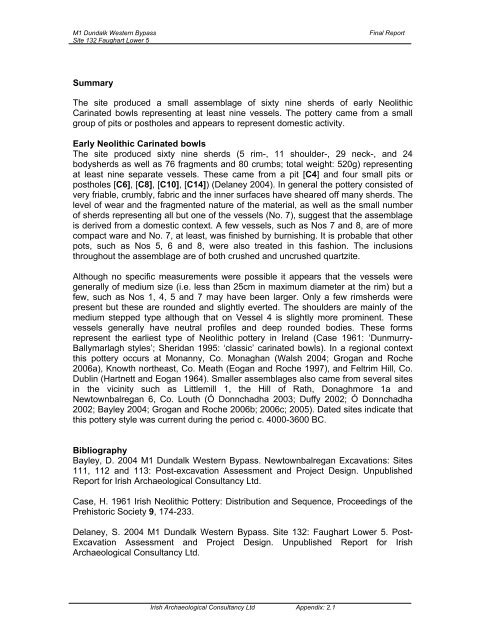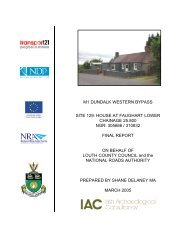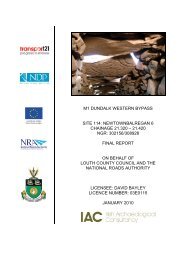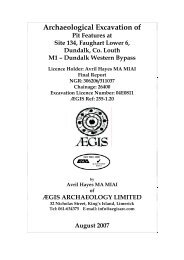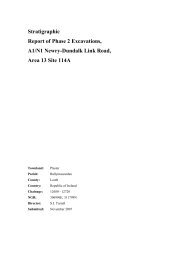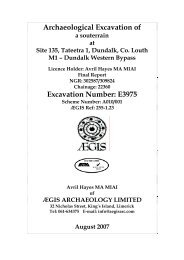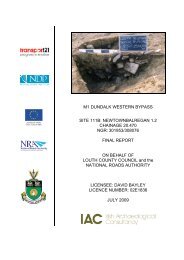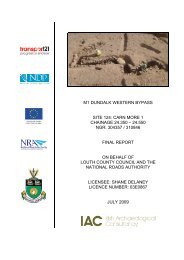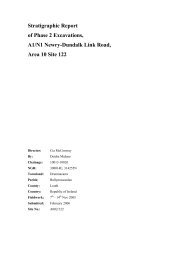Faughart Lower 5 Final Report - ASI Louth
Faughart Lower 5 Final Report - ASI Louth
Faughart Lower 5 Final Report - ASI Louth
You also want an ePaper? Increase the reach of your titles
YUMPU automatically turns print PDFs into web optimized ePapers that Google loves.
M1 Dundalk Western Bypass<br />
Site 132 <strong>Faughart</strong> <strong>Lower</strong> 5<br />
<strong>Final</strong> <strong>Report</strong><br />
Summary<br />
The site produced a small assemblage of sixty nine sherds of early Neolithic<br />
Carinated bowls representing at least nine vessels. The pottery came from a small<br />
group of pits or postholes and appears to represent domestic activity.<br />
Early Neolithic Carinated bowls<br />
The site produced sixty nine sherds (5 rim-, 11 shoulder-, 29 neck-, and 24<br />
bodysherds as well as 76 fragments and 80 crumbs; total weight: 520g) representing<br />
at least nine separate vessels. These came from a pit [C4] and four small pits or<br />
postholes [C6], [C8], [C10], [C14]) (Delaney 2004). In general the pottery consisted of<br />
very friable, crumbly, fabric and the inner surfaces have sheared off many sherds. The<br />
level of wear and the fragmented nature of the material, as well as the small number<br />
of sherds representing all but one of the vessels (No. 7), suggest that the assemblage<br />
is derived from a domestic context. A few vessels, such as Nos 7 and 8, are of more<br />
compact ware and No. 7, at least, was finished by burnishing. It is probable that other<br />
pots, such as Nos 5, 6 and 8, were also treated in this fashion. The inclusions<br />
throughout the assemblage are of both crushed and uncrushed quartzite.<br />
Although no specific measurements were possible it appears that the vessels were<br />
generally of medium size (i.e. less than 25cm in maximum diameter at the rim) but a<br />
few, such as Nos 1, 4, 5 and 7 may have been larger. Only a few rimsherds were<br />
present but these are rounded and slightly everted. The shoulders are mainly of the<br />
medium stepped type although that on Vessel 4 is slightly more prominent. These<br />
vessels generally have neutral profiles and deep rounded bodies. These forms<br />
represent the earliest type of Neolithic pottery in Ireland (Case 1961: ‘Dunmurry-<br />
Ballymarlagh styles’; Sheridan 1995: ‘classic’ carinated bowls). In a regional context<br />
this pottery occurs at Monanny, Co. Monaghan (Walsh 2004; Grogan and Roche<br />
2006a), Knowth northeast, Co. Meath (Eogan and Roche 1997), and Feltrim Hill, Co.<br />
Dublin (Hartnett and Eogan 1964). Smaller assemblages also came from several sites<br />
in the vicinity such as Littlemill 1, the Hill of Rath, Donaghmore 1a and<br />
Newtownbalregan 6, Co. <strong>Louth</strong> (Ó Donnchadha 2003; Duffy 2002; Ó Donnchadha<br />
2002; Bayley 2004; Grogan and Roche 2006b; 2006c; 2005). Dated sites indicate that<br />
this pottery style was current during the period c. 4000-3600 BC.<br />
Bibliography<br />
Bayley, D. 2004 M1 Dundalk Western Bypass. Newtownbalregan Excavations: Sites<br />
111, 112 and 113: Post-excavation Assessment and Project Design. Unpublished<br />
<strong>Report</strong> for Irish Archaeological Consultancy Ltd.<br />
Case, H. 1961 Irish Neolithic Pottery: Distribution and Sequence, Proceedings of the<br />
Prehistoric Society 9, 174-233.<br />
Delaney, S. 2004 M1 Dundalk Western Bypass. Site 132: <strong>Faughart</strong> <strong>Lower</strong> 5. Post-<br />
Excavation Assessment and Project Design. Unpublished <strong>Report</strong> for Irish<br />
Archaeological Consultancy Ltd.<br />
Irish Archaeological Consultancy Ltd Appendix: 2.1


